|
By: Saswat Routray Unknown to most, the Srikshetra of Puri is the home to the biggest RELIGIOUS CARNIVAL of India- something that is 1000 years old. Durga Puja is actually a spring festival. Infact, Basanti Durga Puja is still celebrated in Odisha. The first instance of Sharadiya Durga Puja or Durga Puja during autumn began on the 6th day of Navaratri by Shree Ramachandra which falls in the Ashwina month of the Hindu calendar. Shree Rama worshipped Mahishasura-mardini Devi Katyayini (Maa Durga) seeking her blessings in the war against Ravana. It is to be noted that, Devi Kalika is the Kuladevi of Shree Rama. Eons later, the worship of Maa Durga during this period became the part of Kalinga tradition and came to be known as Gosani Jatra. 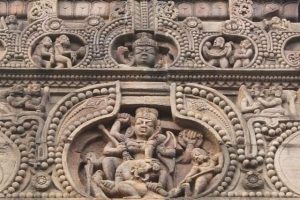 In the 11th century, the founder of the Eastern Ganga Dynasty, the mighty monarch Anantavarman Chodaganga Deva took the reigns of Kalinga in his hands. On the ruins of the ancient dilapidated Jagannathaa temple which was reconstructed after being demolished by Ashoka, he built a new one which is the current day Jagannathaa temple, Puri. The temple complex of Jagannatha Dham, Puri is home to many residing deities and hence, is a hub of various religious cultures like Vaishnavism, Shaivism, Shaktism, Ganapatya, etc. Apart from rebuilding the Jagannathaa temple, Anantavarman Chodaganga also began the ritual of Shakti Puja during Navratri in 11th century following the instructions of his tantric guru Nitei Dhobini. Along with the Shakti Pujan tradition, he also laid the founding stone of Puri’s indigenous religious carnival called “Gosani Jatra” which has inspired the modern day Durga Puja held during the Navratris. Anantavarman started the culture of Gosani Jatra on the 12th day of Durga Puja, where Mother Goddess would come out of her temple and give Darshan to her children on huge decorated pandals. Durga Puja is celebrated for 16-days in Odisha and is still being practiced in all the Devi Temples in the state. That’s how the current form of Durga Puja came into existence and spread all over East India gradually.
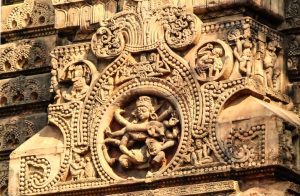 In Puri, the festival of Gosani Jatra/Katyayani Durga Puja is a big endeavour celebrated with much grandeur. Maa is worshipped in various decorated pandals for 4 days. Those 4 days are considered among the most auspicious in an Odia household, since Maa Durga is considered the matriarch of our family. People soak themselves in divinity and recitation of Chandi Patha is done diligently in every household and pandal.During the Gosani Puja festival of Puri, several big clay idols of Mahisamardini Durga are worshipped every year in the month of Ashwina (October). The clay idols are made by using chikita mati (clay), gobara (cowdung) & nadaa (paddy straw). The ‘Gosani Yatra’ is indigenous to Puri, since no outer influence could be noticed, be it in clay model, decoration, colour application, postures, ornamentations, etc or even in the names of the Gosanis. The idols are colored using primary colours like hingula, sankha, geru and lamp black. The 10 handed Gosanis carry various ashtra-shastras in each hand and are mostly yellowish (pitabha body color) & light while the demons are greenish/bluish. Unlike the general Durga idols, the Gosani looks fiery and enraged with her eyes gazing downwards towards Mahishasura. The idols portray severe physical altercation like pulling the demon’s hair with her hands, strangulating or choking him with tight grip or piercing him with her trident while kicking him in the chest. The demon, in most cases, is depicted in theriomorphic (buffalo headed human) form & while some in anthropomorphic (having human characteristics) forms. These highly physical altercations and combat stances are influenced by the Mahisamardini sculptures found on the Kalinga temple walls like Vaital Deula, Parasurameswara Temple, etc. Though she is in fierce stance while slaying the demon, a Gosani grants fearlessness and peace to her kids, like an old grandmother bringing you gifts while visiting you once a year.  Most people outside Odisha don’t know that the residing Goddess Bimala of Jagannatha Dham is also the residing Bhairavi. She is the manifestation of Shakti herself and thus, the prime face of Shaktism in Srikshetra. The Mahaprasada which we consume attains the status of Mahaprasada only after the Uchhistas of Jagannatha is offered to Devi Bimala. After Devi is done with Jagannatha’s Ucchista, her Uchhista (Ucchista of Jagannatha’s Ucchista) becomes the Mahaprasada. It is believed that Jagannatha had promised her that she will be the first one to get his prasada and after she is done with his leftover food, the leftovers will be given to the devotees.Once a year, the Goddess Bimala is worshipped in Tantrik rituals during the Durga Puja and the Goddess is offered with separate non-vegetarian bhog prepared only for her by sacrificing a male sheep late in the dark night. Only the few Shakti priest and the chief priest of the Devi are allowed during this secret ritual. The entire ritual have to be carried out before Jagannatha wakes up during sunrise so that he doesn’t become angry. 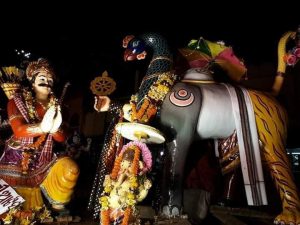 The Gosanis are various manifestation of Devi Bimala, the Shakti. The term “Gosani” is derived from the Odia word “Gosamani”, which means “aristocratic lady”, mistress of cattle (Goswamini), the wife of the Brahmin Lord (Gosein) or the paternal grandmother (Gosein Maa). In royal families of Odisha, the princesses are called “Jenamani” or “Jemamani”. In this way the paternal great grandmother is called ‘Gosamani’. The local people believe the Gosanis as the saviour and nourisher of their locality and therefore, during Durga Puja festival they use to worship Gosani images in their respective Sahis (Street or regions).The Gosanis represent several aspects of Mahishasura-mardini Durga at Puri and are worshipped during the Durga Puja festival. Every Gosani has a particular name to indicate her individuality & belonging to a Sahi (lane) or village. Every village in Odisha has their own vernacular name for Devi Durga with which they refer to her. In some village or locality she’s called Kakudikhaai (she who eats cucumbers) while somewhere else she’s called Janhikhai (she who eats ridge gourd), etc. There are other repeated names too, like Basantitei, Harachandi etc. The names are rather crude & local, suggesting their connection to local tribes and villages and with their folk culture. For example, the Kakudikhai Sunya Gosani fights the buffalo-demon in the sky while the Kantakadhi (thorn-removing) Banadurga stands with one raised leg. Needless to say, Gramadevati/Devi culture still thrives and is widely prevalent in Odisha.
The various Gosanis are depicted with all her Saubhagya Aalankar and traditionally the Medhaw or the huge decoration on the backside of the idol is one of the highlights of the Sharadiya Durgotsab/Gosani Jatra. The decorations of Gosanis are colorful and grandeous. Originally, the crown, ornaments, attributes and the halo are being decorated with traditional Sola and Jari work. Like Gosani, gigantic images of Naga (from Puri’s Sahi akhada culture), symbolising heroism & valour, are also made and worshipped during the festival. During the Durga Puja/Navratri, apart from worshiping the Gosani pratimas, devotees often carry out the Gosani idols in carnival (Jatra). Apart from Gosani idols, there are several other pratimas and idols depicting Pauranic events like Ravana lifting Mahalingam, Kartik slaying demon, Shiva doing Tandava, etc. 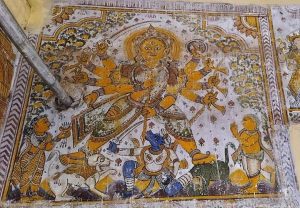 Apart from religious and spiritual importance, the Durga Puja in Odisha has historical importance too. After rebuilding the Jagannatha temple, Anantavarman Chodaganga started the tradition of recording down all historical events as chronicle.According to the tradition, Chodaganga created 24 families of Karanas to preserve the temple records. Of these, five were entrusted with the year-to-year writing and preservation of the Madala Panji, the chronicles that contains all the historical events of Kalinga. They were: • Panjia Karan—preserves the Madala Panji. • Tadau Karan—writes the Madala Panji. • Deula Karan—enforces the Madala. • Kotha Karan—the main compiler. • Baithi Karan – assistant.The Karanas used to record down all the historical events in their respective copies, and on the day of Bijaya-Dashami (Vijaya-Dashami) these events were finally recorded in the Madala Panji, on annual basis. 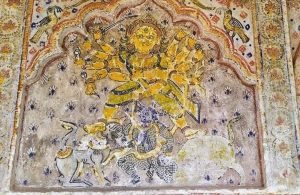 A couple of centuries later, the scions of his dynasty had showed what true monarchs are. When the raging horde of Turkic invaders were riding along to invade their lands by killing every city on its way, emperor Anangabhima Deva, true to his title of Durgaputra, shattered the invading army and defended his empire. It is said that each year, he used to pay his thanks to the Devi on Bijaya Dashami for being able to successfully defend his empire against Turkic nemesis. Devi gifted him with a son who would surpass him in many ways in the coming years.Like his father Anangabhima Deva, Langula Narasimha Deva also took the title of Durgaputra, Rudraputra (inscribed in Kapilasa) and took the fight against the Turkic invaders to their own region- the Bengal under the Sultanate. To commemorate his successful campaigns against the foreign invaders, he built the massive Konark temple, which according to many scholars, was commissioned on Bijaya Dashami. The might of this monarch is evident from the fact that when foreign invaders were raging down the Nalanda University just a few hundred miles away, the grand Konark temple was being constructed under the patronage of Langula Narasimha Deva.  Religiousness and Spirituality in Odisha is of different kind. Jagannatha is the religious identity and unity of Odisha, while Shakta Sampraday is the driving adrenaline in Odia diaspora. The martial clan of Khandayat community too is close to Shakti worship. Odisha had a long history of Shakta Sampraday and Tantra culture too. Durga Puja is an important festival for us.
|
|
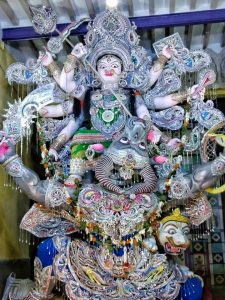
Unique one ?